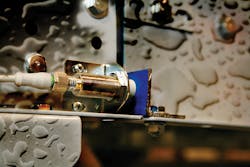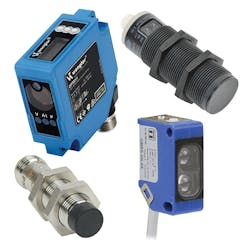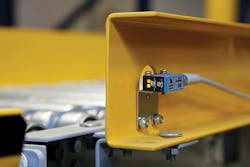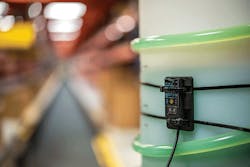This file type includes high resolution graphics and schematics when applicable.
Proximity, capacitance, and photoelectric sensors play an important role in the robust control of industrial machines. To select the proper sensor for a given job, engineers should start with a clear understanding of the application requirements, sensor specifications, and installation demands. Here’s a look at the importance of factors like sensing distance, environmental effects, connectivity concerns, and mounting options.
Sensing Basics
All sensor applications have certain specific needs, and a good place to start when selecting a sensor is to review basic sensor selection criteria. Users need to determine:
• Targets the sensor must detect
• Objects and backgrounds the sensor must not detect
• The best sensing technology for detecting only the targets
• Available mounting space and restraints
• Sensor form factor
• Electrical requirements
• Cabling requirements
• Mounting requirements (see "Sensor Mounting Considerations")
Engineers must first understand and identify targets and backgrounds. Targets are the objects, parts, ink marks, or empty spaces the sensor must detect. Backgrounds are everything else that should not be detected, and sometimes take the same form as the aforementioned targets. For example, the target could be a brown cardboard box traveling on a conveyor, while the background might be an empty space or a worker walking next to the conveyor.
Next, select the best type of sensor that detects the target while ignoring the background. The installation environment and other constraints may affect this decision.
Key differences in sensing technology drive selection as engineers must consider what is sensed and how it is being sensed. Sensing distance and environmental effects also help determine the final choice of sensor.
Proximity Sensors
Inductive proximity sensors generate a magnetic field from an inductive coil, which is disturbed when a ferrous target is present. Standard inductive sensors only detect ferrous objects, but they do so consistently and repeatably with little interference from ambient elements. Unfortunately, these sensors only detect metal and some metals, such as stainless steel, reduce sensing distance.
Proximity sensors have sensing ranges from <1 to 120 mm, with longer ranges requiring larger sensors. For example, sensors with a sensing range of 2 to 25 mm are supplied in 8 to 30 mm diameter housings, respectively.
Photoelectric Sensors
Photoelectric sensors use light to detect objects. They emit and receive light at certain wavelengths: infrared, visible red, or laser light. The emitter and receiver may be in one housing (common in diffuse and retroreflective configurations) or in two separate housings (common in through-beam configurations). Photoelectric sensing is quite versatile, as these sensors can detect very small objects made of many different material types at considerable distances.
However, photoelectric sensors can be influenced by ambient conditions, and many require programming during installation to optimize operation. These sensors are the most sensitive to dirt and debris, which can cause false triggers by interfering with the operation of the emitter and receiver.
On the other hand, photoelectric sensors have the broadest sensing range. With laser light they can detect objects just a few microns thick. A photoelectric laser sensor can also be configured to detect a target whether positioned close to or far from the target, due to the power of a focused laser beam. Less-expensive infrared and visible red photoelectric sensors have sensing ranges from 100 mm with diffuse beam, and up to 50 m with through-beam.
Capacitive Sensors
Capacitive sensors essentially look for the dielectric or density in a sensing area. They can detect almost any object, but fare better with high-density objects. Capacitive sensors are ideal for sensing levels of liquids or bulk dry materials. The switching threshold can be adjusted to “tune out” items that should not be detected—a plastic tank wall or a cardboard box, for example. These sensors can be influenced by ambient materials and have a relatively small sensing range.
Capacitive sensors generally have sensing ranges less than 60 mm, although this distance is strongly influenced by the target’s dielectric value.
Connection Options
Sensors commonly connect to controllers such as PLCs or PLC-based PACs. Electrically, most modern sensors use low-voltage dc control power, typically 24 V dc; 120 V ac is also available. Discrete sensors primarily provide solid-state positive-to-negative (PNP) or negative-to-positive (NPN) switching outputs, and analog sensors commonly have 0- to 10-V or 4- to 20-mA outputs.
Most sensors require a specific switching type, either PNP or NPN. However, some sensors can be modified for either type, as well as for other options. These sensors let programming, switch configuration, or wiring of the device determine the switching type at the time of installation. Similar options are available for normally open and closed switching states.
Whether the connection is to the sensor or a photoelectric sensor amplifier, a variety of cabling options are available. Prewired cables have the cable molded into the sensor. This usually is the least expensive option and simplifies purchasing. Another benefit is the molded cable works well with small sensors as it permits mounting in tight spaces. However, prewired cables are restricted to available lengths—for the most part, approximately 2 to 5 meters. When the sensor fails, the cable must be rerun and secured, increasing installation time.
Quick-disconnect cables have become an extremely popular choice. These cables let technicians add a cable, of any length or material, independent of the sensor. Once installed, changing failed sensors is quick and simple. But while quick-disconnect cable options are plentiful, they can add cost and complicate the purchasing process.
Quick-disconnect plugs are becoming an industry standard. Precut 2- to 15-m length cables are typically available in axial and right-angle configurations, with M8 or M12 size screw-lock connectors on one end and flying leads at the other end. Regardless of the sensor selected, the specified cable must work with the electrical configuration of the sensor. For example, M8 and M12 connectors commonly come in 3- and 4-pole configurations for sensors. The number of pins must also be carefully specified.
Application Guidelines
When properly specified, most sensors can function in a variety of applications. However, although there is much overlap in sensor application, there are cases where one sensor technology works better than the others.
For example, sensing end-of-travel of a pneumatic or motor-driven actuator and sensing metal objects are common applications for an inductive proximity switch. Once a premium product, these simple and robust devices are some of the most commonly used today due to more competitive pricing. If there is a ferrous target within a close distance, the inductive proximity sensor is the best choice due to its rugged design and minimal effects from outside influence. Common uses include detecting presence of a metal part, conveyor pallet, or gear teeth—or detecting actuator movement and home position.
Photoelectric sensors are versatile sensors which work well in a wide range of applications. Common uses include sensing part presence in a fixture or sensing parts on a conveyor. Using the precision of a laser, even small printed circuit board components can be detected. It is also possible to measure height of an object from meters away. Detecting print marks on a high-speed labeling machine or counting bottles on a filling line are common uses for standard photoelectric sensors. However, placing the sensor under water or where it may be splashed with oil or process fluid can cause sensing issues.
A key feature of capacitive sensors is the ability to see through paper, plastic, and cardboard boxes. These sensors can also sense liquid presence, or detect an object traveling through a liquid. Counting machined brass fittings passing the sensor while submerged in cutting fluid is feasible with a capacitive sensor, but not with other types. This adjustability permits detection of a variety of liquid and solids, including water, oil, chemicals, powders, and grains.
Sensing liquid level through tank walls, sight glasses, or in a mounting well for both high and low level are other primary applications for capacitive sensors. When mounted closely enough, the capacitive sensor can also detect fill level in boxes or opaque bottles.
This file type includes high resolution graphics and schematics when applicable.
Each of these sensing technologies affects sensing range (distance). While a longer sensing range may seem like a better choice, consider the application carefully to minimize false triggering of a sensor.
Andrew Waugh is Safety and Sensor Product Manager at AutomationDirect, Cumming, Ga.






